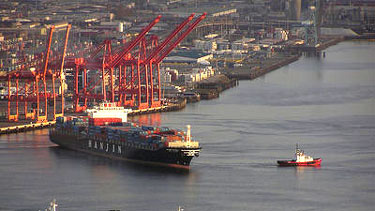

Monday, April 21, 2014
Top Story
Report: Container shipping vulnerable at Puget Sound ports
 The container shipping business at Puget Sound ports is vulnerable to poaching by competitors on the East and West coasts and exacerbated by the lack of cooperation and the inter-regional competition between the ports of Seattle and Tacoma, according to a report by logistics advisers Mercator International.
The container shipping business at Puget Sound ports is vulnerable to poaching by competitors on the East and West coasts and exacerbated by the lack of cooperation and the inter-regional competition between the ports of Seattle and Tacoma, according to a report by logistics advisers Mercator International.
KING 5 News recently discovered the report, conducted on behalf of an undisclosed terminal operator, through a Public Disclosure Request to the Port of Seattle. It gives new credence to the notion that the two Washington ports should merge.
Last month the Federal Maritime Commission sanctioned a request from the ports of Tacoma and Seattle to begin information exchanges aimed at boosting container traffic in the Puget Sound region.
The report suggests the marine operations at both ports are well below capacity, and must undergo major improvements to stay competitive.
Although Tacoma's container traffic has increased the past two years after luring the Grand Alliance shipping consortium away from Seattle, the Port of Seattle has noted that the competition between the two ports hasn't increased the overall volume of goods handled through the Puget Sound.
Mercator determined that discretionary intermodal rail traffic accounts for 47 percent of container volume at both Puget Sound ports, and since imports exceed exports in the region, import cargo flows determine the level of traffic that moves in each direction. (Since imports generate the empty containers returning to Asia, much of the "export" flow is driven by imports.) Consequently, the report concludes, Seattle and Tacoma must protect and improve their share of discretionary intermodal traffic to survive.
The 11-page report documents Mercator's analysis of the ports' maritime operations. For example, it says as of 2013, the Elliot Bay container terminal capacity utilization at the Port of Seattle is estimated "to be just 38 percent." The document says the port needs improved on-dock rail, but it has been limited in its ability to improve due to space limitations near Terminal 46.
The report goes on to say the ports need costly improvements to handle bigger ships. Ports in places like British Columbia, Southern California and the East Coast have been dredging and improving in hopes of handling bigger ships once the expanded Panama Canal is operational in 2015.
Recently, Port of Seattle CEO Tay Yoshitani suggested consolidation is something that ports like Seattle should consider.
"Nothing is off the table," said Yoshitani. "The shipping lines are consolidating to form alliances, and it might be worthwhile for the ports to look at it." He said the Seattle port's talks with the Port of Tacoma were confidential.
For more of the King 5 News report: king5.com
More Newswire stories
Industrial real estate market performance up in first quarter
Ag group: Documentation rules in Japan and EU imperil U.S. agriculture exports
China union to mediate shoe factory strike involving 40,000 workers
Container ship collides with rig vessel and bulker runs aground off Virginia
Home | The Magazine | Conferences | Port Handbooks | Newswire | Advertise | Ocean Schedules | Contact
CBN Archives | About CBN | Subscribe to CBN | Heartland Shippers’ Conference | CalExport Conference | Southeast Freight Conference | Port Productivity Conference | Pacific Northwest Ports Handbook | Golden Gates Ports Handbook | Southern California Ports Handbook | Buy Handbooks | Subscirbe to Newswire | Newswire Archives | Upload Files




